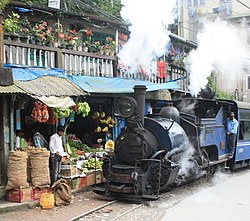| Darjeeling Himalayan Railway | |||||
|---|---|---|---|---|---|
 Passing a fruit shop in Darjeeling | |||||
| Terminus | Darjeeling | ||||
| Commercial operations | |||||
| Built by | Franklin Prestage | ||||
| Original gauge | 610 mm (2 ft) | ||||
| Preserved operations | |||||
| Owned by | Indian Railways | ||||
| Operated by | Northeast Frontier Railway | ||||
| Stations | 17 | ||||
| Length | 83.9 km | ||||
| Commercial history | |||||
| Opened | 1881 | ||||
| Preservation history | |||||
| Headquarters | Elysia Place, Kurseong | ||||
| Website | |||||
| dhr | |||||
| Part of | Mountain Railways of India | ||||
| Criteria | Cultural: (ii)(iv) | ||||
| Reference | 944ter-001 | ||||
| Inscription | 1999 (23rd Session) | ||||
| Extensions | 2005, 2008 | ||||
| Area | 5.34 ha (13.2 acres) | ||||
| Buffer zone | 70 ha (170 acres) | ||||
| Coordinates | 26°40′48″N 88°27′36″E / 26.68000°N 88.46000°E | ||||
| |||||
The Darjeeling Himalayan Railway, also known as the DHR or the Toy Train, is a 610 mm (2 ft) gauge railway that runs between New Jalpaiguri and Darjeeling in the Indian state of West Bengal.[1] Built between 1879 and 1881, it is about 88 km (55 mi) long. It climbs from about 100 m (330 ft) above sea level at New Jalpaiguri to about 2,200 m (7,200 ft) at Darjeeling, using six zig zags and three loops (originally five) to gain altitude. Ghum station is situated at an altitude of 2,258 metres (7,407 ft). Six diesel locomotives handle most of the scheduled service, with daily tourist trains from Darjeeling to Ghum – India's highest railway station – and the steam-hauled Red Panda service from Darjeeling to Kurseong. Steam-enthusiast specials are hauled by vintage British-built B-Class steam locomotives. The railway's headquarters are at Kurseong.
On 5 December 1999, UNESCO declared the DHR a World Heritage Site.[2] Two more railway lines were later added, and the site became known as one of the mountain railways of India.
- ^ The Darjeeling Himalayan Railways dhr.indianrailways.gov.in. Retrieved 30 August 2021
- ^ "Mountain Railways of India". UNESCO World Heritage Centre. Retrieved 30 April 2006.

